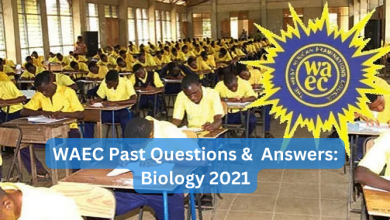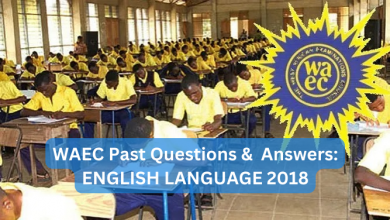WAEC Past Questions & Answers: BIOLOGY 2022

Welcome to our WAEC past question and answer series. In this post, we will be sharing ‘recent’ past questions and their answers for various subjects. Stay tuned enjoy while learning.
1. The scientist who introduced binomial nomenclature in the classification of organisms was…
A. Charles Darwin
B. Carolus Linnaeus
C. John Ray
D. Louis Pasteur
C. Metathorax bears only wings
D. Prothorax bears only wings
3. What level of organisation is Spirogyra?
A. Organ system
B. Organ
C. Cell
D. Tissue
4. The streaming movement of cytoplasm within paramecium is known as…
A. Transpiration
B. Digestion
C. Cyclosis
D. Osmosis
5. Which of the following organelles is found only in plant cells?
A. Mitochondria
B. Ribosomes
C. Lysosomes
D. Plastids
6. Active transport differs from diffusion in that active transport
A. Is a very fast process
B. Allows the movement of substances against concentration gradient
C. Takes places in both light and dark reactions of photosynthesis
D. Occurs in both plant and animal tissues.
The diagrams below are illustration of an experimental set-up to demonstrate a type of tropic response in plants. Study them and answer question 7 and 8
7. The type of response demonstrated is
A. Phototropism
B. Geotropism
C. Hydrotropism
D. Thigmotropism
8. The conclusion drawn from the experiment is that
A. Shoots of plants are negatively thigmotropic.
B. Shoots of plants are negatively geotropic.
C. Leaves of plants are positively phototropic.
D. Roots of plants are positively hydrotropic.
9. The odontoid process is found on the
A. Axis vertebra
B. Atlas vertebra
C. Thoracic vertebra
D. Sacral vertebra
10. A seedling was made to stand in a solution of red ink for three hours and a transverse section of the stem was examined under the microscope. The process being investigated was
A. The importance of micro elements of plants.
B. Ascent of water through the xylem.
C Diffusion of coloured substances.
D. Distribution of food in plants.
11. Which of the following structures would carry out respiration?
A. Germinating cowpea.
B. Decolorized leaf
C. Dry leaf.
D. Boiled cowpea
12. Which of the following substances is not an excretory product of animals?
A. Carbon dioxide
B. Urea
C. Sweat
D. Oxygen
13. An example of homeostasis in living organisms is
A. Cooling effect resulting from evaporation of water from the body surface.
B. Root hairs of a plant growing toward a source of light
C. Changing of the body colour of chameleon to match the colour of the foliage on which it is resting.
D. The release of phosphorus into the phloem of a plant growing in a phosphorus-deficient soil
14. Ultrafiltration in the kidney takes place in the
A. Renal vein
B. Medulla
C. Loop of Henle
D. Bowman’s capsule
15. The thyroid gland is located at the base of the
A. Midbrain
B. Kidney
C. Neck
D. Liver
16. Which of the following statements about the response of neurons to stimulus is correct?
A. Neurones respond to stimulus of any strength.
B. Neurones respond to all stimuli applied in rapid succession.
C. Neurones respond more rapidly during the absolute period.
D. Intensity of stimulus must reach a threshold value before the neurones can be excited.
17. Which of the following practices may lead to infection of the eye? Use of
A. Contact lenses
B. Convex lenses
C. Biconcave lenses
D. Concave lenses.
18. The structures for gaseous exchange in breathing roots are
A. Stomata
B. Lenticels
C. Cuticles
D. Mitochondria
The diagram below is an illustration of the life cycle of an insect. Study it and answer question 19 and 20
19. The adult insect in this life cycle is
A. Housefly
B. Butterfly
C. Cockroach
D. Mosquito
20. The larva is also known as
A. Nymph
B. Maggot
C. Caterpillar
D. Chrysalis
21. The source of energy required by plants during food production is
A. Photosynthesis
B. Chlorophyll
C. Sunlight
D. Microorganisms
22. One major difference between plant and animal nutrition is the ability of plants to synthesise
A. Food for plants and animals
B Water for plants
C. Water for animals
D. Food for plants only.
23. By what process is starch converted into maltose?
A. Hydrolysis
B. Condensation
C. Translocation
D. Photosynthesis
24. The ascent of water in tall tree is mainly due to
A. Adhesive forces
B. Transpiration pull
C. Root pressure
D. Cohesive force
25. The duodenum of a person was surgically removed. Which of the following substances would have their digestion affected?
A. Starch and protein only
B. Starch and lipids
C. Starch, protein and maltose
D. Starch, protein and lipids.
26. Which of the following dental formulae represents the dentition in rabbits?
A. 12/1 C 0/0 P 3/2 M 2/3
B. 1 2/2 C 1/1 P 2/2 M 3/3
C. 1 ½ C 0/0 P 2/3 M 3/3
D.1 2/1 C 0/1 P 3/2 M 3/3
The diagram below is an illustration of an experimental set-up to
Demonstrate a property of soil. Study it and answer question 27 and 28

27. The property of soil demonstrated is
A. Particle size
B. Capillarity
C. Colour
D. Texture
28. Which of the following statements would be a correct observation at the end of the experiment? Water moves
A. Highest in sandy soil
B. Lowest in loamy soil
C. To the same level in all soil types
D. Highest in clayed soil.
29. The most important factor(s) that influence(s) the ecological niche of an organism is/are the
A. Water, light and predator-prey relationship.
B. Food and water availability.
C. Physical environment.
D. Competition for food and space
30. The diagram below is an illustration of organisms in an air-tight aquarium. The most important factor needed by the organism is

A. Light energy
B. Low humidity
C. Oxygen
D.Nitrate
31. Which of the following instruments is used to determine the turbidity of water?
A. Hygrometer
B. Hydrometer
C. Secchi disc
D. Rain gauge
32. In an ecosystem, the least efficient energy transfer link is from the
A. Secondary consumers to decompose.
B. Sun to producers
C. Primary consumers to secondary consumers.
D. Producer to primary consumers.
33. Xerophytes have the following characteristics aimed at conserving water except
A. Thick cuticle
B. Broad leaf surfaces.
C. Sunken stomata
D. Waxy cuticle
34. An association between living organisms in which one lives on and feeds at the expenses of the other is known as
A. Commensalism
B. Predation
C. Parasitism
D. Mutualism
35. When large numbers of organisms share limited space and resources, the immediate result is
A. Extinction
B. Emigration
C. Competition
D. Immigration
36. Which of the following diseases is caused by a bacterium?
A. Ringworm
B. Poliomyelitis
C. Syphilis
D. Malaria
37. Conservation of wildlife is necessary mainly because
A. Wild species cannot resist diseases better than their domesticated species.
B. Many predator wild animals help in the control of pests
C. It prevents the extinction of species
D. Many people derive pleasure from observing wild animals.
Two conscious patient X and Y whose blood group genotypes are AO and AB respectively were transfused with blood from the same donor. Patient X immediately showed signs of difficulty in breathing while patient Y showed no negative reaction.
Use the information above to answer questions 38 and 39.
38. Patient X and Y were likely transfused with blood of genotype
A. OO
B. AO
C.BO
D. AA
39. What should the hospital have done to prevent patient X from showing the symptom described above? Patient X should have
A. Undergone an agglutination test
B. Been asked for the blood group.
C. Been screened for HIV
D. Undergone malaria test.
40. The greatest contribution to genetic studies was made by…
A. Gregor Mendel
B. Thomas Morgan
C. Charles Darwin
D. Robert Hooke.
41. The exchange of genes between homologous chromosomes is called
A. Crossing over
B. Back cross
C. Test cross
D. Mutation
The diagrams below are illustration of the inheritance of coat in mice. J, K, L, M and N are parents. The crosses between two parent mice gave rise to offspring P, Q, R and S. study the diagram and answer question 42 and 43

42. Which parent mouse is heterozygous for coat colour…
A. M
B. J
C. K
D. L
43. Which of the offspring are all homozygous?
A. P
B. Q
C. S
D. R
44. Genes that remain linked are those
A. Close to each other on the chromosomes.
B. On the same locus on the chromosomes
C. On the homologous chromosomes
D. Which are allelic pair
45. A plant cell has 14 chromosomes prior to mitosis. What is the number of chromosomes in the daughter cells?
A. 14
B. 56
C. 28
D. 7
46. The chemical bonds the bases of the two strands of DNA together is
A. Oxygen
B. Hydrogen bond
C. Electrovalent bond
D. Covalent bond
The diagram below is an illustration of one of the theories of evolution. Study it and answer questions 47 and 48

47. Who proposed the theory in the illustration?
A. Louis Pasteur
B. Gregor Mendel
C. Robert Hooke
D. Jean Lamarck
48. The theory supports
A. Struggle for survival
B. Natural selection
C. Independent assortment.
D. The use and disuse of body parts
49. In evolution, fossils are naturally preserved in
A. Rocks
B. Water
C. Chemicals
D. Trees
50. Which of the following insects is not a social insect?
A. Termite
B. Bee
C. Housefly
D. Ant
Answers To Questions
- D
- B
- C
- C
- D
- D
- B
- C
- A
- C
- A
- D
- B
- D
- C
- D
- C
- B
- B
- B
- C
- A
- A
- B
- D
- D
- B
- C
- D
- C
- C
- A
- B
- C
- C
- C
- C
- C
- A
- A
- A
- C
- B
- A
- A
- B
- B
- D
- A
- C





